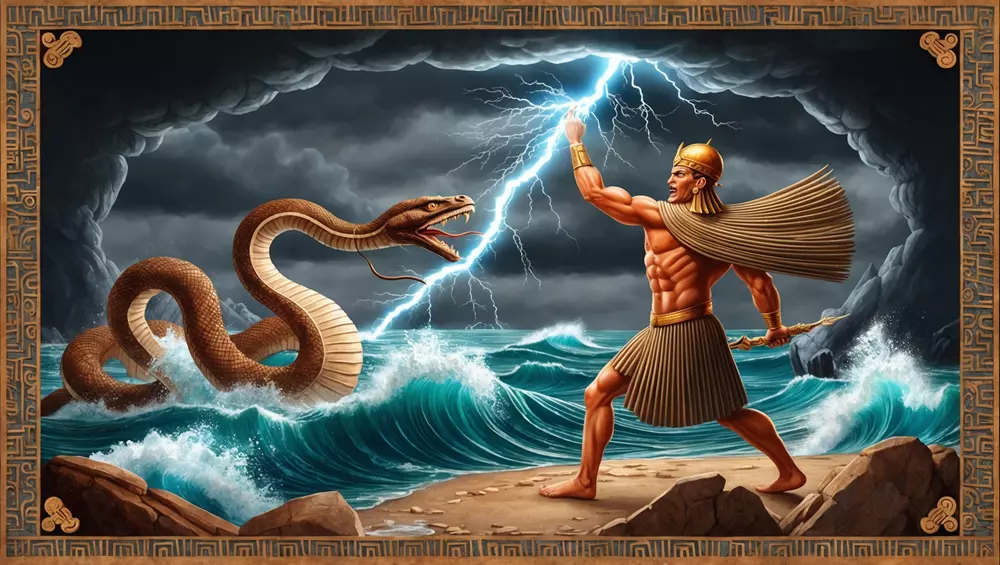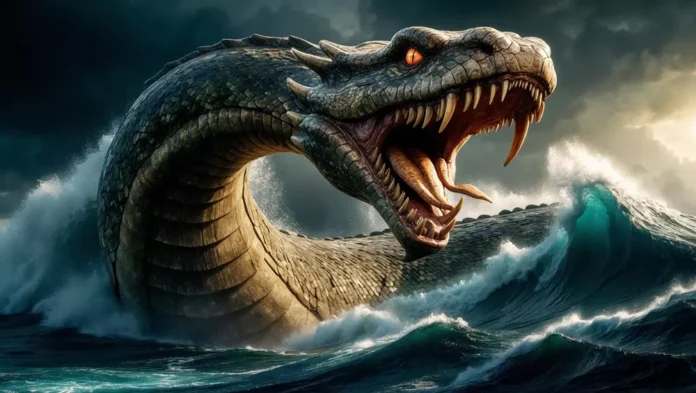Tanin: The Ancient Dragon Serpent of Chaos
The Tanin, often translated as “dragon” or “sea monster,” is a fearsome creature from ancient mythology, particularly within the Jewish and Near Eastern traditions. Associated with chaos and destruction, the Tanin is a serpentine beast that is both feared and respected for its immense power. Its tales intersect with some of the most significant myths of creation and cosmic conflict, symbolizing the battle between order and chaos.
Origins and Mythological Background
The Tanin finds its origins in the ancient Near East, with its earliest mentions in Mesopotamian and Jewish texts. The creature appears in the Hebrew Bible and other ancient texts, often as an embodiment of primordial chaos, much like the Babylonian Tiamat or the Canaanite Lotan. The term “Tanin” itself means “serpent” or “dragon,” and the creature is frequently depicted as a massive, writhing serpent capable of laying waste to entire realms.
The Tanin in Mesopotamian Mythology
The Tanin shares many characteristics with the ancient Mesopotamian serpent-dragon Tiamat, a creature that battled the god Marduk in the Babylonian creation epic, Enuma Elish. In this tale, Tiamat personifies the chaotic waters of the primordial sea, opposing Marduk who represents order. The concept of a monstrous sea serpent that threatens the gods and the world order is a recurring motif, reflecting ancient concerns with chaos and disorder.
The Battle of Lotan and Baal: A Primordial Clash of Chaos and Storm

In ancient Canaanite mythology, Lotan is a sea serpent embodying the chaotic forces of the deep, primordial waters. As a servant of Yam, the sea god, Lotan exists as a symbol of untamed nature, representing the chaotic and destructive aspects of the ocean. His presence signifies the threat that unrestrained chaos poses to the world, with his serpentine body twisting and churning through the dark seas.
In this myth, Lotan faces the storm god Baal, who personifies order, power, and control over nature’s unruly forces. Baal, wielding a mighty lightning bolt, rises as the force of stability against Lotan’s chaos. Their battle is epic and fierce, as Baal seeks to restore balance by subduing the monstrous serpent. Lotan’s thrashing body and the turbulent waves create a scene of primordial fury, with the clash representing the timeless struggle between chaos and order.
The myth of Lotan and Baal reflects the ancient Canaanite understanding of nature’s duality, where the unpredictable power of the sea must be confronted by divine intervention to ensure the world’s stability. In their clash, Lotan embodies the fearsome unpredictability of nature, while Baal’s victory symbolizes the triumph of order over disorder, bringing peace to the tumultuous seas.
The Tanin is similarly depicted in the Hebrew Bible, where it is described as a creature that dwells in the seas and stands as a symbol of divine power and chaos. In some texts, it is linked to the Leviathan, another monstrous sea creature, suggesting that the Tanin may have been a name or a type of creature within a larger class of mythological sea monsters.

Tanin in Jewish Lore
In Jewish texts, particularly the Talmud, the Tanin is often mentioned alongside the Leviathan as a creature that will be slain at the end of days to provide a feast for the righteous. The Tanin, in this context, symbolizes the chaotic forces that oppose God and that must ultimately be subdued. Rabbinic interpretations of the Tanin frequently see it as a representation of the ultimate adversary, a force of nature that must be conquered to establish divine order.
Cultural Impact and Evolution
The Tanin’s role as a symbol of chaos and destruction has had a lasting impact on the cultures that revered it, shaping their mythologies and worldview. Its association with the primordial waters and its role in cosmic battles reflect a deep-seated fear and respect for the untamable aspects of nature.
Influence in Ancient Rituals and Beliefs
In ancient Near Eastern societies, the Tanin likely influenced rituals aimed at appeasing the gods and ensuring their favor. For example, rituals and offerings to sea deities may have been influenced by myths of the Tanin and similar creatures, reflecting a desire to control or appease chaotic forces. The Tanin also served as a cautionary figure, a reminder of the dangers that lurk in the unknown and the need for divine protection.
The Tanin in Later Jewish Symbolism
In later Jewish thought, the Tanin became a symbol of God’s dominion over chaos. The rabbis of the Talmudic era and later Jewish mystics often used the Tanin as an example of God’s power to control even the most fearsome creatures. This shift reflects the evolving understanding of chaos within Jewish theology, from an opposing force to one that is ultimately under divine authority.
Symbolism and Archetypes
The Tanin embodies the archetype of the chaos monster, a creature that exists beyond the bounds of civilization and order. It represents the fears and anxieties of ancient peoples facing an unpredictable and often hostile natural world.
The Chaos Monster Archetype
As a chaos monster, the Tanin represents the untamed aspects of the cosmos that defy human understanding. It is often depicted as a serpent or dragon, creatures that have long been associated with both creation and destruction across cultures. The Tanin’s existence serves as a reminder of the limitations of human control over nature and the necessity of divine intervention.
Modern Representations in Popular Culture
The Tanin has continued to capture the imagination, appearing in various forms of modern media and popular culture. While not as widely recognized as dragons or other mythical creatures, the Tanin’s themes of chaos and destruction resonate in contemporary storytelling.
Literature and Film
In literature, the Tanin appears as a symbol of ancient forces that characters must confront to achieve their goals. Some authors have explored the Tanin as a metaphor for inner chaos or the darker aspects of human nature. Though rare, references to the Tanin can be found in fantasy novels that draw on Near Eastern mythology, where it serves as an antagonist or a powerful force of nature.
Video Games and Modern Media
In video games, the Tanin is sometimes adapted as a monstrous boss character or a representation of elemental power. Games that explore themes of mythology and ancient history may include creatures inspired by the Tanin, especially those that involve battles against primordial forces. The Tanin’s characteristics of strength and chaos make it an ideal adversary in settings where players must overcome formidable challenges.
Conclusion
The Tanin is a powerful symbol of chaos and destruction, a creature that embodies the fearsome aspects of nature and the unknown. Through its ancient stories and continued presence in modern culture, the Tanin remains a reminder of humanity’s ongoing struggle to understand and control the world around it. Its legacy as a creature of legend continues to inspire awe and caution, cementing its place in the pantheon of mythological beasts.










